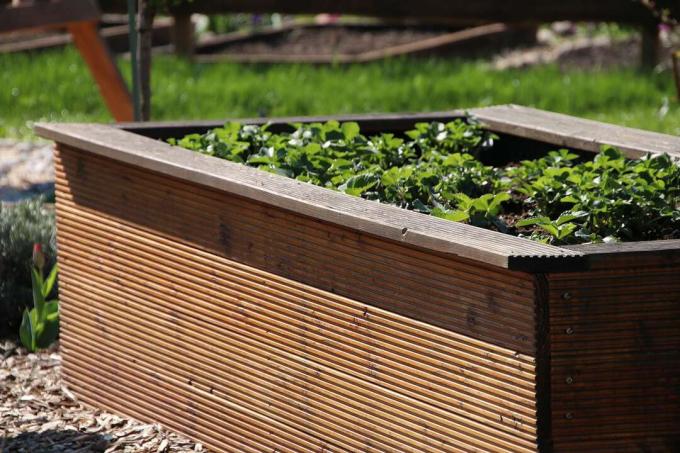
Conventional raised beds are filled with layers of different materials. But can you only fill the raised bed with soil? If so, for which types of raised beds and with which plants?
In a nutshell
- Filling with soil possible
- Offers advantages and disadvantages
- Useful for some types of raised beds
- Cannot be planted without restrictions
Table of contents
- Advantages and disadvantages
- Raised Bed Types
- Appropriate planting
- Small selection of herbs
- Suitable vegetables
- frequently asked Questions
Advantages and disadvantages
Depending on what kind of raised bed is to be planted with what, it can also be filled exclusively with soil. opposite one conventional layering it has both advantages and disadvantages.

Advantages
- similar filling as flower boxes and planters
- less time and effort
- significantly less filling quantity required
- no complex layering
- Soil only sags shortly after filling
- regular refilling is not necessary
- especially with small and flat raised beds
Disadvantages
- not suitable for all types of raised bed
- not recommended for growing vegetables
- Content of natural nutrients significantly lower
- no rotting process therefore no heat development
- regular fertilization required
Raised Bed Types
In principle, raised beds of different sizes can only be filled with soil.
This form of filling is particularly suitable for smaller raised beds that are not suitable for layering. These can be table raised beds or plant tubs or troughs. Due to the lower weight, they are ideal for balconies and terraces. The filling is done in two layers, namely a drainage layer and soil. The latter usually only has to be as high as the later planting grows in depth. Depending on the size of the raised bed, it is filled with good potting soil or different soils.

Example of filling:
- below drainage of expanded clay, gravel or crushed stone
- then a structurally stable, peat-free soil
- depending on the size, a second layer of earth
- from special raised bed soil
- tailored to raised bed cultures
- has a balancing effect in dry and wet weather
Depending on what you want to plant with, you can also use high-quality vegetable or compost soil. In the best case, you mix something beforehand mature compost below, if any. Or you spread a layer of garden or compost soil on the drainage and then a layer of ripe compost of the same thickness or a special raised bed soil suitable for vegetables and herbs. A fleece between the drainage and the soil prevents both layers from mixing.
Tip: The higher the soil in the raised bed, the lower the risk of it drying out in the heat.
Appropriate planting
Actually, a raised bed created with soil can be equipped with almost all plants that are also grown in a conventional raised bed. However, they should not grow too much. The right soil, the size of the bed or the depth of the earth. Depending on the season, different types of vegetables and herbs as well as flowers can be planted. When it comes to herbs, it should be noted that soft-leaved species require more nutrients and moisture than hard-leaved ones. And if done wisely, it can be harvested from spring to autumn.
Small selection of herbs
parsley, basil, chives, lemon balm, coriander, lovage, dill, rosemary, thyme, mint, lavender, sage, marjoram, chamomile, lemon balm, savory, oregano
Suitable vegetables
In the spring:
Lettuce and lettuce, broad beans, radishes, leeks, mangetout, beetroot, kohlrabi, Garlic

In summer:
snack and mini cucumbers, paprika, bush tomatoes, bush beans and courgettes
In autumn/winter:
Lamb's lettuce, spinach, palm cabbage, Asian salads, winter purslane, winter onion sets
In addition to herbs and vegetables, always bearing strawberries or edible flowers on how Nasturtium, marigold, begonia, pansies, and chrysanthemums tagetes. Another factor when planting is the orientation of the raised bed. The more hours of sun it gets per day, the greater the choice of plants. A north-south orientation is ideal for vegetables and herbs, for example.
Tip: Since fresh soil is usually pre-fertilized, no additional fertilizer needs to be applied initially. After about half a year, the nutrients have been used up to such an extent that it has to be fertilized again.
frequently asked Questions
In any case, you should pay attention to high-quality soil. Poor-quality soil often tends to clump, which can damage the roots of the plants. In addition, it should be as peat-free as possible.
When it comes to fertilization, it again depends on the planting, how high the respective requirement is. It is advisable to use a complete liquid fertilizer, or at best a special plant fertilizer, depending on the nutrient requirements of the crops being grown.
That depends on the size of the raised bed and its capacity utilization. how much it is used. The soil in a bed with a capacity of 40 liters should be changed every year, but at the latest every second year. In the case of larger specimens, you usually do not exchange them completely, but replace about half of the soil with fresh ones.
Smaller plant tubs or troughs hold about 20 liters. The somewhat more commonly used and more common table raised beds can hold 40-60 liters.
It is of particular interest to those who do not have any own compost available, for example because they live in the city. So you can also fulfill your dream of a raised bed there. For particularly small specimens, it can also be used as sole soil.
